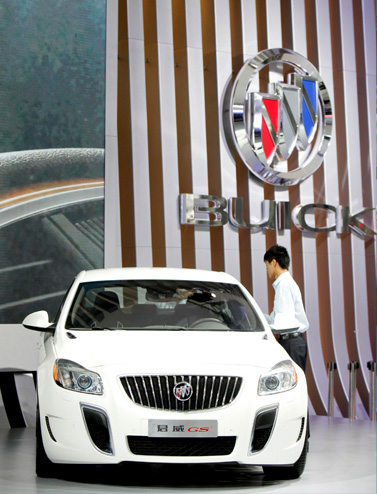Cars
Slowing car sales to hit automakers
By Fang Yan and Ken Wills (China Daily)
Updated: 2011-02-19 10:32
 |
Large Medium Small |
|
 |
|
A visitor examines a GM Buick Regal model at an auto exhibition in Guangzhou. General Motors saw a 50.3 percent jump in sales of its mid-sized Buick models in January, more than double the annual growth rate in 2010. [Photo / Agencies] |
The withdrawal of tax perks and more regulation of registrations may prompt a fall in demand
BEIJING - Automakers in China shipped 16.2 percent more cars to dealers in January as they moved aggressively to replenish inventories that were nearly depleted after explosive sales in December.
However, the world's largest auto market will lose some momentum in the coming months, after the government stripped away most of its incentives at the start of the year, industry observers said.
"Dealerships across the country were crowded in December as people sought to take advantage of government incentives before their expiration. Many were actually paying the money upfront and waiting for months to get their cars," said Boni Sa, an analyst with IHS Automotive.
"The Chinese lunar new year also bolstered demand for big-ticket items, but the following months could be challenging for automakers."
Many Chinese typically go on a spending spree ahead of the week-long Spring Festival holiday, which ran from Feb 2 to Feb 8 this year.
However, the holiday binge for autos actually started in December as many consumers rushed to showrooms to take advantage of Beijing's tax incentives for small cars that expired at the end of 2010.
A raft of stimulus measures introduced at the beginning of 2009 helped China surpass the United States as the world's top auto market in that year. Some of those measures included subsidies to farmers who traded in old and gas-guzzling vehicles for more fuel-efficient models.
Now that the incentives have been stripped away, industry observers say demand for small cars, which accounted for roughly 60 percent of the country's passenger car sales, will decline, biting into the overall volume.
BYD Co Ltd, backed by the US billionaire Warren Buffett, has already slashed prices of five models by up to 20 percent, a move which might trigger a price war in the lower-end segment, analysts say.
Still, the market is projected to grow by between 10 and 15 percent for the full year as first-time buyers are now turning to bigger and pricier models instead.
General Motors Co, for example, saw a 50.3 percent jump in sales of its mid-sized Buick models in January, more than double the annual growth rate in 2010.
Ford Motor Co moved 19,734 units of its Focus model, a monthly record.
A total of 1.53 million sedans, sports-utility vehicles and multi-purpose vehicles were sold in January nationwide, the China Association of Automobile Manufacturers said on Friday.
That compared with 1.3 million wholesale car sales in December, a rise of 18.6 percent from a year earlier, according to official data.
In Beijing's first public lottery for new car registration last month, only 17,600 out of a pool of 187,420 applicants won the right to buy a car.
"The effect is limited on China's overall car sales as Beijing makes up less than 5 percent of the national tally. But we don't know how many other cities will follow suit and what steps they will take," said Sheng Ye, associate research director at the industry consultancy, Ipsos' China.
"If all major cities also come out aggressively, automakers will certainly feel the pain."
Reuters
| 分享按钮 |



